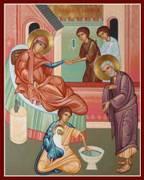Nativity of Theotokos
 Objectives:
Objectives:
- Students should recognize the characters in the icon and tell its story.
- Students should know that we celebrate this feast on September 8.
Possible Lesson Plan:
- Open with prayer.
- Discuss the icon to see how much the students already know: St. Anna is the central figure, an elderly woman robed in blue and lying on a bed. The figures surrounding her are nurses. The Theotokos appears as an infant in the arms of a nurse being pondered by her mother and also with a nurse in a cradle being pondered by her father, St. Joachim, who appears in the lower right as an elderly man with white hair. Why are Joachim and Anna so old?
- Tell the story, if they don’t already know it:
Joachim and Anna were a righteous couple. But despite years of prayers, they had no children and were getting quite old, too old for children. They went to the temple constantly, praying and offering sacrifices for a child. Now, for the Jewish people, not having any children was considered a disgrace; the couple must be very wicked if God would not bless them even with a child. One day, Joachim brought yet another offering to the temple. The priest was so angry to see him yet again that he threw Joachim out of the temple. Joachim went to the hills outside the city and there prayed and fasted for forty days. An angel appeared to him and told him that they would have a baby, and this baby would be blessed by God. The angel appeared at the same to Anna at home. They ran to meet each other at the gates of the city, full of joy.
Nine months later, the baby was born. She was given the name Mary. The righteous couple promised the Lord that this child would be dedicated to Him; this promise was later fulfilled with the presentation of Mary at the temple.
- Scripture readings:
Gospel: Luke 10:38-end, 11:27-28
Epistle: Philippians 2:5-11
Old Testament: Genesis 28:11-17, Ezekiel 43:27-44:14, Proverbs 9:1-11
- Songs of the Feast:
Troparion: Thy nativity, O Theotokos, hath proclaimed joy to the whole universe; for from thee did shine forth the Sun of Justice, Christ our God, annulling the curse and bestowing the blessing, abolishing death and granting us life everlasting.
Kontakion: By thy holy birth-giving, O pure one, Joachim and Anna were delivered from the reproach of barrenness; and Adam and Eve were delivered from the corruption of death; thy people do celebrate it, having been saved from the stain of iniquity, crying unto thee, The barren doth give birth to the Theotokos, who nourisheth our life.
- Discussion questions:
Why is this feast first in the liturgical year? What is the importance of the Theotokos? In what way, does our hope begin here? How does our view of the Theotokos differ from the views of the Protestant denominations?
What are some other stories of women who prayed and were granted by the Lord “miraculous” babies? (Sarah, Hannah, and later, Elizabeth) In what way do Joachim and Anna fulfill Adam and Eve? How does Jacob’s ladder (Genesis 28) relate to the Theotokos? (She is the ladder who reunites heaven and earth.)
What does the reading from Philippians, which doesn’t even mention Mary, have to do with her feast? God empties Himself (known as “kenosis”) to become human; Mary is the instrument of this Incarnation.
The Roman Catholic has in recent centuries adopted the doctrine of the “Immaculate Conception”, referring to the conception of Mary. This stems from their concept of “original sin”; if we are all born with the guilt of sin (and not just the predisposition to sin), then Mary would be sinful and Jesus would be born with sin as well. Discuss the Orthodox concept of sin, Adam and Eve, and why we have not needed an “Immaculate Conception” for Mary. This is important for teens to understand in preparation for discussions with Roman Catholic classmates.
7. Close with prayer.